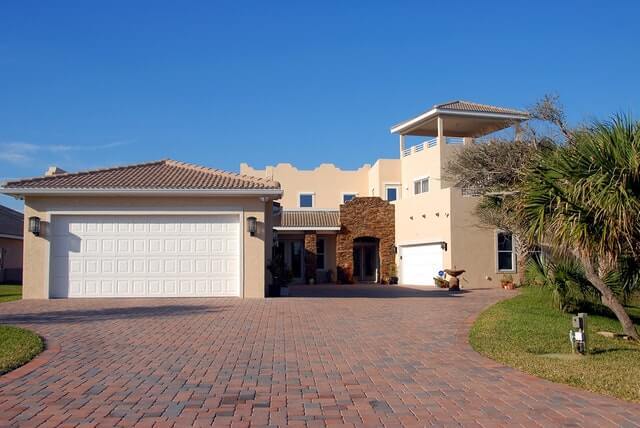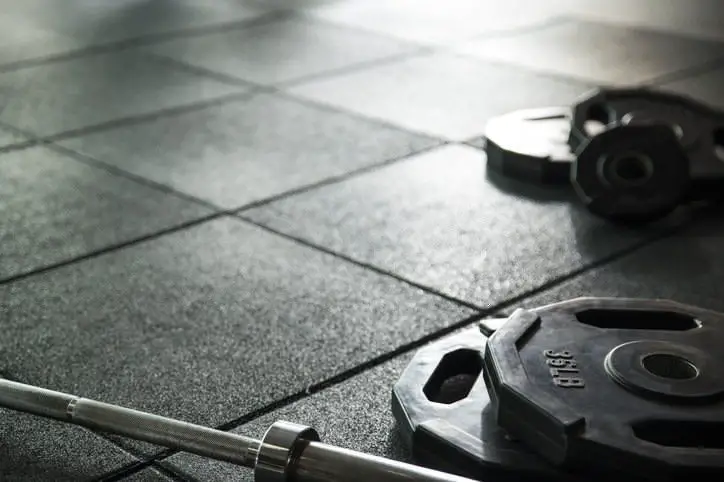The days when a garage was used for storing your car along with a few tools and tins of paint have long since gone.
If you’re not using your garage to store all the junk you have no other space for then you may decide to use it as a home gym, music room or a place for your band to practice in. All of these can create a lot of noise.
Fortunately garages are ideal spaces for loud activities because often they are sealed off from the rest of the house, making them relatively easy to soundproof.
To soundproof your garage follow the steps below, we have put them in order of effectiveness so if you only have the time or budget to do one or two of these then start with the methods at the top of the list:
1. Soundproof The Garage Door
Garage doors are notoriously bad at blocking sound, if you are serious about soundproofing your garage then sorting the garage door is where you should start.

Typically garage doors are made from uninsulated sheets of aluminum, steel or vinyl which provide little sound resistance. If you start slamming weights around or playing loud music your garage door can’t be relied upon to stop your neighbors hearing anything.
Soundproofing a garage door is made difficult by the fact that mass blocks sound. You can only add so much mass to your door before it will be too heavy to open smoothly and it could also be dangerous.
The best way to soundproof your garage door is to do the following things:
1. Clad the door interior with moving blankets
Moving blankets are thick blankets designed to protect furniture and possessions from getting damaged during transit.
They are lightweight (compared to other soundproofing materials) but dense enough to deaden sound in your garage. You can use short screws or zip ties to fasten the blanket to the inside of your door. Cover the entire garage door completely for the most effective results. Covering your door with moving blankets will help deaden sound inside your garage too, thereby reducing echo and improving acoustics (handy if you plan on using your garage as a recording studio or similar).
If you are willing to spend a bit more money you could instead buy acoustic blankets which are specifically designed to reduce echo and dampen sounds.
2. Fit a garage door side seal around the frame
Garage doors aren’t known for being airtight and if they let air in they will let noise in (and out). So sealing your garage door is a vital step towards fully soundproofing your garage.
To do this get a garage door seal for the side of your garage door and fit it into the frame. When completed the garage door should touch the rubber when closed sealing the door and also allowing it to close more quietly.
3. Install an garage door bottom seal
If when closed the bottom of your garage door isn’t perfectly flush with the floor gaps will allow noise to easily escape. You can fix this by fitting a garage door bottom seal. These are rubber lips that stand proud of the floor, when your garage door is closed they meet the rubber and create a seal.
One final soundproofing factor to be aware of with garage doors is that if you use an automatic garage door opener this can create quite a lot of noise and will more than likely disturb whoever is sleeping in the room above the garage – not ideal if you need to take the car out early in the morning!
If this is true for you, then it’s a good idea to invest in a purpose-made quiet garage door opener to keep noise to a minimum.
Even if you have completely soundproofed your garage door this doesn’t mean that your garage door itself will be quiet, especially if it has noisy rollers, creaky hinges and it rattles a lot there is still plenty more you can do to quiet your garage door.
2. Other Interior Doors
Most homes have an internal door leading to the garage. Soundproofing your interior door is vital if you are going to keep your family happy and avoid noise traveling into the rest of the house.
Below is a basic breakdown of what you need to do to soundproof your interior garage door:
- Install weather stripping or fit a magnetic door gasket to seal the door.
- Fit MDF panels to the door to add mass to it.
- Fit a door sweep or acoustic threshold to close up the gap at the bottom.
- Swap hollow doors for a solid wood door.
For a detailed explanation of how to complete each step read our article on how to soundproof a door.
3. Soundproof Your Garage Ceiling
Top Tip: Soundproofing your garage ceiling is very important ifyou have a room above it, we recommend installing a garage door silencer if you have a garage door opener installed – this will make a big difference to the amount of vibrations travelling through your ceiling. If your garage is a stand-alone garage with no room above then the ceiling need not be a priority.
To soundproof the ceiling of your garage follow these three steps:
- Insulate the ceiling cavity – Remove the ceiling plasterboard and fill the space between your ceiling joists with flame-resistant insulating foam such as Rockwool.
- Install resilient channels – resilient channels are long and metallic, they are designed to decouple your ceiling. They do this by creating minimal contact with the ceiling joists which is padded with rubber so that noise transfer through the ceiling is reduced. Fix these to your ceiling joists.
- Replace plasterboard with soundproof ceiling panels – if your budget is tight feel free to skip this step, but if you want maximum soundproofing then it is worth investing in soundproof ceiling panels to further reduce sound transfer. Fix these to your resilient channels and you’re done!
4. Soundproof The Walls
There are a number of ways you can soundproof a wall.
The simplest and easiest way is to fit soundproof panels to your garage wall. Soundproof wall panels are between 25mm to 40mm and usually have a rubber core to deaden vibrations. They come in sizes of around 1m x 1m. Simply buy enough to cover your wall and screw them into place.

Another very effective and affordable way of soundproofing your walls is to use soundproof curtains or blankets. Use hooks to hang these from your ceiling against the wall so that they fall all the way down to the floor.
This deadens sound vibrations before they hit the wall minimizing noise and helping to soundproof your garage. If you find that this method is ineffective try doubling or even tripling up the fabric to make it thicker.
Be aware that if you have an exhaust fan in your garage sound can easily escape through your wall through these. We recommend that you do two things to minimise this:
- Get a quiet garage exhaust fan to minimise fan noise in the garage.
- Use a long outlet pipe a position the outlet strategically to minimise noise disruption.
5. Soundproof Your Garage Floor
Soundproofing your garage floor is very important if you plan on using your garage as a gym, particularly if you are going to lift weights in there.
Dropping weights creates big vibrations which will travel throughout your whole house and disturb everyone.

Clad your entire floor with rubber matts, this is what commercial gyms do for noise reduction.
Rubber matts mean that falling weights don’t immediately fall to a dead stop, but instead they stop more gradually as the momentum is absorbed. Thereby lowering the frequency of the noise and reducing the noise volume.
We also recommend getting a couple of extra thick additional matts to put in places where you expect weight to regularly moving (such as under either end of a deadlift bar).
If you are not planning on using your garage as a gym rubber matting can be an effective means of soundproofing but it is not necessary.
A Cheaper Alternative..
A cheaper method which will work if you plan to use your garage as a music or band practice room is to lay down some old carpet and old carpet underlay. If you have enough spare double it up for extra soundproofing.
6. Windows (If Your Garage Has Any)
Most garages don’t have windows but if you’re bothering to read this then your garage probably does.

Because garages aren’t used as living spaces windows are often single pane (particularly in older homes), if this is the case for your window by far the most effective thing you can do to soundproof it is to replace it with a double or even triple-glazed window.
If you already have a double-glazed window in your garage you can further soundproof it by:
- Filling gaps in your window frame with acoustic sealant.
- If your window opens, fit weather stripping around the inside of the frame to make it fully airtight when closed.
- Fit acrylic panels on your windows, these are see-through panels which fit over your existing windows effectively adding a cheap extra layer of glazing.
Read our article for more detailed information on how to soundproof your windows.
7. The Room Inside A Room Method
The room with a room method is the most effective soundproofing solution for any type of room.
It is an alternative to the wall and ceiling soundproofing methods mentioned above.
This method involves building a secondary wall and ceiling within your room thus creating an additional cavity which traps noise.
To create a room inside a room within your garage you will need timber to create a frame for your new wall and plenty of drywall cladding (if it’s in your budget we recommend soundproof drywall).
Build a stud frame that covers the entire wall area and also fit secondary ceiling joists.
Before nailing in the drywall you can fill the spaces between the joists with insulation foam for extra soundproofing.
Then nail in the drywall ensuring that the entire frame is concealed behind it and your room looks like a normal room once again (rather than a building site).
Then simply decorate and you’re all done.
Final Thoughts On Garage Soundproofing
As we mentioned at the start of this article these methods can be used in isolation or together.
The most effective method of soundproofing any room including your garage is to use the room inside a room method, however this will reduce the available square meters.
If you only have time or budget for a few small tweaks then we strongly recommend that you soundproofing your garage door (this is vital for anyone who has easily irritated neighbors) and soundproof your internal garage door will make a significant difference to whoever you share your home with.
Soundproofing your garage doesn’t have to be expensive, it can be down with old carpet old blankets, a bit of weather stripping and minimal D.I.Y skills if needs be, or you can go all out and build a room within a room, the choice is yours!
As an Amazon Associate I may earn a small fee from qualifying purchases at no extra cost to you. This helps us run the site, so thanks for your support!


